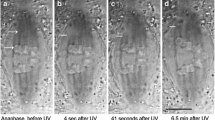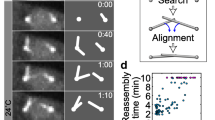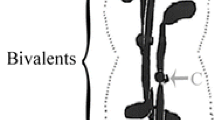Abstract
The relationship between chromosome movement and mirotubules was explored by combining micromanipulation of living grasshopper spermatocytes with electron microscopy. We detached chromosomes from the spindle and placed them far out in the cytoplasm. Soon, the chromosomes began to move back toward the spindle and the cells were fixed at a chosen moment. The microtubules seen in three-dimensional reconstructions were correlated with the chromosome movement just prior to fixation. Before movement began, detached chromosomes had no kinetochore microtubules or a single one at most. Renewed movement was always accompanied by the reappearance of kinetochore microtubules; a single kinetochore microtubule appeared to suffice. Chromosome movements and kinetochore microtubule arrangements were unusual after reattachment, but their relationship was not: poleward forces, parallel to the kinetochore microtubule axis (as in normal anaphase), would explain the movement, however odd. The initial arrangement of kinetochore microtubules would have led to aberrant chromosome distribution if it persisted, but instead, reorientation to the appropriate arrangement always followed. Observations on living cells permitted us to place in sequence the kinetochore microtubule arrangements seen in fixed cells, revealing the microtubule transformations during reorientation. From the sequence of events we conclude that chromosome movement can cause reorientation to begin and that in the changes which follow, an unstable attachment of kinetochore microtubules to the spindle plays a major role.
Similar content being viewed by others
References
Begg DA (1975) Chromosome movement following detachment from the meiotic spindle by micromanipulation. J Cell Biol 67:25a
Begg DA, Ellis GW (1979a) Micromanipulation studies of chromosome movement. I. Chromosome-spindle attachment and the mechanical properties of chromosomal spindle fibers. J Cell Biol 82:528–541
Begg DA, Ellis GW (1979b) Micromanipulation studies of chromosome movement. II. Birefringent chromosomal fibers and the mechanical attachment of chromosomes to the spindle. J Cell Biol 82:542–554
Church K, Lin H-P (1982) Meiosis in Drosophila melanogaster. II. The prometaphase-I kinetochore microtubule bundle and kinetochore orientation in males. J Cell Biol 93:365–373
Dietz R (1956) Die Spermatocytenteilungen der Tipuliden. II. Graphische Analyse der Chromosomenbewegung während der Prometaphase I im Leben. Chromosoma 8:183–211
Dietz R (1958) Multiple Geschlechtschromosomen bei den cypriden Ostracoden, ihre Evolution und ihre Teilungsverhalten. Chromosoma 9:359–440
Margolis RL, Wilson L (1981) Microtubule treadmills — Possible molecular machinery. Nature 293:705–711
McIntosh JR, Euteneuer U (1984) Tubulin hooks as probes for microtubule polarity: An analysis of the method and an evaluation of data on microtubule polarity in the mitotic spindle. J Cell Biol 98:525–533
Mitchison T, Kirschner M (1984) Microtubule dynamics and cellular morphogenesis. In: Borisy GG, Cleveland DW, Murphy DB (eds) Molecular biology of the cytoskeleton. Cold Spring Harbor Laboratory, Cold Spring Harbor, pp 27–44
Mitchison T, Kirschner M (1985) The properties of the kinetochore in vitro. II. Microtubule capture and ATP-dependent translocation. J Cell Biol (in press)
Moens PB, Moens T (1981) Computer measurements and graphics of three-dimensional ultrastructure. J Ultrastruct Res 75:131–141
Nicklas RB (1967) Chromosome micromanipulation. II. Induced reorientation and the experimental control of segregation in meiosis. Chromosoma 21:17–50
Nicklas RB (1971) Mitosis. In: Prescott DM, Goldstein L, McConkey E (eds) Advances in cell biology, vol 2. Appleton-Century-Crofts New York, pp 225–297
Nicklas RB (1977) Chromosome distribution: Experiments on cell hybrids and in vitro. Phil Trans R Soc Lond B227:267–276
Nicklas RB (1983) Measurements of the force produced by the mitotic spindle in anaphase. J Cell Biol 97:542–548
Nicklas RB, Gordon GW (1985) The total length of spindle microtubules depends on the number of chromosomes present. J Cell Biol 100:1–7
Nicklas RB, Staehly CA (1967) Chromosome micromanipulation. I. The mechanics of chromosome attachment to the spindle. Chromosoma 21:1–16
Nicklas RB, Brinkley BR, Pepper DA, Kubai DF, Rickards GK (1979) Electron microscopy of spermatocytes previously studied in life: Methods and some observations on micromanipulated chromosomes. J Cell Sci 35:87–104
Nicklas RB, Kubai DF, Hays TS (1982) Spindle microtubules and their mechanical associations after micromanipulation in anaphase. J Cell Biol 95:91–104
Östergren G (1951) The mechanism of co-orientation in bivalents and multivalents. Hereditas 37:85–156
Rieder CL (1982) The formation, structure, and composition of the mammalian kinetochore and kinetochore fiber. Int Rev Cytol 79:1–58
Salmon ED, Leslie RJ, Saxton WM, Karow ML, McIntosh JR (1984) Spindle microtubule dynamics in sea urchin embryos: Analysis using a fluorescein-labeled tubulin and measurements of fluorescence redistribution after laser photobleaching. J Cell Biol 99:2165–2174
Solari AJ, Counce SJ (1977) Synaptonemal complex karyotyping in Melanoplus differentialis. J Cell Sci 26:229–250
Author information
Authors and Affiliations
Rights and permissions
About this article
Cite this article
Nicklas, R.B., Kubai, D.F. Microtubules, chromosome movement, and reorientation after chromosomes are detached from the spindle by micromanipulation. Chromosoma 92, 313–324 (1985). https://doi.org/10.1007/BF00329815
Received:
Revised:
Issue Date:
DOI: https://doi.org/10.1007/BF00329815




